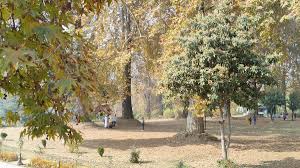Chinar Trees

- 22 Jan 2025
In News:
The J&K Forest Department, in collaboration with the J&K Forest Research Institute (JKFRI), has launched a pioneering conservation initiative to digitally preserve the iconic Chinar trees (Platanus orientalis)—a vital part of Kashmir’s ecological and cultural heritage.
Significance of Chinar Trees:
- Locally known as Boonyi or Boueen, Chinar trees are deeply embedded in Kashmir’s cultural identity.
- These deciduous trees can grow up to 30 meters tall with a girth of 10–15 meters, and can live for over 600 years.
- They are known for their seasonal leaf color transformation—from green in summer to red, amber, and yellow in autumn.
- Notable specimens include Asia’s largest Chinar in Ganderbal and the oldest known Chinar (647 years) in Chattergam, Budgam.
Challenges to Chinar Survival:
- Urban expansion and habitat encroachment.
- Climate change, altering precipitation and temperature patterns.
- Illegal felling and timber exploitation.
- Increased susceptibility to pests and diseases.
Tree Aadhaar & Geo-Tagging Initiative:
- Over 28,500 Chinar trees have been geo-tagged and assigned unique Tree Aadhaar numbers from 2021 to 2023.
- Each tree is fitted with a QR-coded digital plate, enabling real-time access to:
- Tree location, height, girth, canopy dimensions
- Health status, ecological threats, and pest presence
- These plates are spring-mounted metal tags to prevent damage to the trees.
Conservation Goals & Future Plans:
- Digital Protection: Enables proactive monitoring and protection through a centralized database.
- Chinar Atlas: A comprehensive mapping of all Chinar trees in the region.
- Public Access Website: A dedicated digital portal is planned for broader access to Chinar data.
- Risk Assessment: Use of USG-based, non-invasive surveys to identify trees at risk without human interference.
- Emphasis on covering remote and restricted areas in future phases to ensure inclusivity in conservation.
